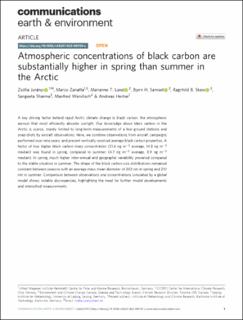| dc.contributor.author | Jurányi, Zsófia | |
| dc.contributor.author | Zanatta, Marco | |
| dc.contributor.author | Lund, Marianne Tronstad | |
| dc.contributor.author | Samset, Bjørn Hallvard | |
| dc.contributor.author | Skeie, Ragnhild Bieltvedt | |
| dc.contributor.author | Sharma, Sangeeta | |
| dc.contributor.author | Wendisch, Manfred | |
| dc.contributor.author | Herber, Andreas | |
| dc.date.accessioned | 2024-02-22T13:02:03Z | |
| dc.date.available | 2024-02-22T13:02:03Z | |
| dc.date.created | 2023-05-09T13:01:41Z | |
| dc.date.issued | 2023 | |
| dc.identifier.citation | Communications Earth & Environment. 2023, 4 (1), . | en_US |
| dc.identifier.issn | 2662-4435 | |
| dc.identifier.uri | https://hdl.handle.net/11250/3119388 | |
| dc.description.abstract | A key driving factor behind rapid Arctic climate change is black carbon, the atmospheric aerosol that most efficiently absorbs sunlight. Our knowledge about black carbon in the Arctic is scarce, mainly limited to long-term measurements of a few ground stations and snap-shots by aircraft observations. Here, we combine observations from aircraft campaigns performed over nine years, and present vertically resolved average black carbon properties. A factor of four higher black carbon mass concentration (21.6 ng m−3 average, 14.3 ng m−3 median) was found in spring, compared to summer (4.7 ng m−3 average, 3.9 ng m−3 median). In spring, much higher inter-annual and geographic variability prevailed compared to the stable situation in summer. The shape of the black carbon size distributions remained constant between seasons with an average mass mean diameter of 202 nm in spring and 210 nm in summer. Comparison between observations and concentrations simulated by a global model shows notable discrepancies, highlighting the need for further model developments and intensified measurements. | en_US |
| dc.language.iso | eng | en_US |
| dc.publisher | Springer Nature ltd | en_US |
| dc.rights | Navngivelse 4.0 Internasjonal | * |
| dc.rights.uri | http://creativecommons.org/licenses/by/4.0/deed.no | * |
| dc.title | Atmospheric concentrations of black carbon are substantially higher in spring than summer in the Arctic | en_US |
| dc.title.alternative | Atmospheric concentrations of black carbon are substantially higher in spring than summer in the Arctic | en_US |
| dc.type | Peer reviewed | en_US |
| dc.type | Journal article | en_US |
| dc.description.version | publishedVersion | en_US |
| dc.source.pagenumber | 0 | en_US |
| dc.source.volume | 4 | en_US |
| dc.source.journal | Communications Earth & Environment | en_US |
| dc.source.issue | 1 | en_US |
| dc.identifier.doi | 10.1038/s43247-023-00749-x | |
| dc.identifier.cristin | 2146420 | |
| dc.relation.project | Norges forskningsråd: 248834 | en_US |
| dc.relation.project | Norges forskningsråd: 314997 | en_US |
| cristin.ispublished | true | |
| cristin.fulltext | original | |
| cristin.qualitycode | 1 | |

